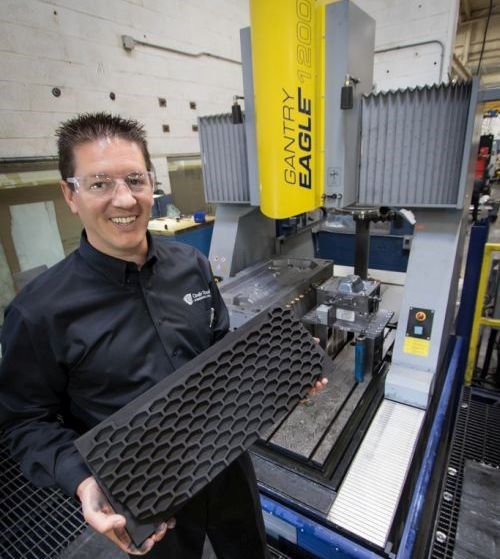RFID to Deliver Material Cost Savings
The 2015 Leadtime Leader award winner expects this technology to offer more than just flexible retrieval of any EDM electrode or blank in a new, automated cell. It will also save on material costs and machining time by ensuring that any electrode can potentially be used for more than one application.

Brian Bendig, president of 2015 Leadtime Leader Award winner Cavalier Tool & Manufacturing, shows off an automotive grill electrode machined on the shop’s OPS Ingersoll Eagle 1200 gantry-type sinker EDM. One of the first of these models installed in North America and available from MC Machinery Systems, this machine saved Cavalier $126,000 in operating and consumable costs in its first year. (Image courtesy of Creative Technology Corp.)
I've seen plenty of high-end machining centers and EDMs at the shops I've visited since coming on board at MoldMaking Technology nearly two years ago. I've also seen plenty of instances of robots tending such machinery. I've even seen all three technologies integrated together in the same cell. It’s far more rare to find a radio frequency identification (RFID) tagging system that enables automated system to retrieve any pallet from any location in the cell without any extra effort from operators or programmers.
Such a system is currently in the works at Windsor, Ontario-based mold manufacturer and 2015 Leadtime Leader Award winner Cavalier Tool & Manufacturing. The shop is currently installing a new EDM cell consisting of a robot-fed five-axis machining center and three sinker EDMs with high-capacity electrode changers. All the operator will have to do is keep the 192-station robot loaded with graphite blanks and move machined 'trodes into any available station on the appropriate EDM. RFID tags on each and every pallet are readable by all of this machinery, thus ensuring the aforementioned flexibility.
Yet, RFID's benefits won't stop with the labor and error reduction that comes with the ability to store 'trodes and blanks in any available station. Bendig says he also expects this capability to deliver significant material cost savings. After all, RFID will minimize the effort of finding and reusing any given electrode, because graphite stays in the same holder from robot to machining center to EDM. "We intend to maintain a library of 'spent' electrodes," he explains. "Two months down the road, if the program calls for something that's a close enough match with something in that library, we can take that electrode and recut it to fit the new job." Compared to cutting an entirely new 'trode, this approach will save both graphite costs and machining time.
Read this June-issue feature article to learn more about Cavalier Tool & Manufacturing.












